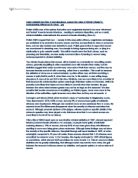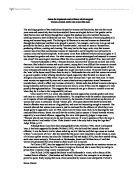Examine some of the reasons why females may be less likely than males to commit crimes
Examine some of the reasons why females may be less likely than males to commit crimes
(12 marks)
A number of sociologists have offered explanations as to why females may be less likely than males to commit crimes. Explanations have been offered through Merton's Strain theory, Labelling theory, Liberal feminists, Radical feminists, Interactionist feminists, Postmodernist feminists, and Heidensohn's explanation of social control to suggest the reasons why women are less criminally inclined.
According to Merton's Strain theory society tends to overemphasise the achievements of goals without paying sufficient attention to the means. The pressure to succeed and obtain momentary wealth is so strong that some groups particularly the working class, will turn to illegitimate means to obtain these goals. However, Eileen Leonard argues that women's goals are relational, not financial as they are more concerned with relationships than financial success. For example women's goals tend to be more personal, i.e. to be a good mum and wife. In the words of Leonard: 'women have low aspirations and their goals are extremely accessible.' Though, postmodernists would argue that in this modern age, with the introduction of women's rights and equal pay; women have become more financially focus, thus partaking in crimes such as corporate crime for financial gain. On the other hand women tend to be very successful in education because they are keen to learn, therefore, they are able to develop the means to achieve their goals. This means that women do not need to commit crime to achieve their goals.
(12 marks)
A number of sociologists have offered explanations as to why females may be less likely than males to commit crimes. Explanations have been offered through Merton's Strain theory, Labelling theory, Liberal feminists, Radical feminists, Interactionist feminists, Postmodernist feminists, and Heidensohn's explanation of social control to suggest the reasons why women are less criminally inclined.
According to Merton's Strain theory society tends to overemphasise the achievements of goals without paying sufficient attention to the means. The pressure to succeed and obtain momentary wealth is so strong that some groups particularly the working class, will turn to illegitimate means to obtain these goals. However, Eileen Leonard argues that women's goals are relational, not financial as they are more concerned with relationships than financial success. For example women's goals tend to be more personal, i.e. to be a good mum and wife. In the words of Leonard: 'women have low aspirations and their goals are extremely accessible.' Though, postmodernists would argue that in this modern age, with the introduction of women's rights and equal pay; women have become more financially focus, thus partaking in crimes such as corporate crime for financial gain. On the other hand women tend to be very successful in education because they are keen to learn, therefore, they are able to develop the means to achieve their goals. This means that women do not need to commit crime to achieve their goals.








